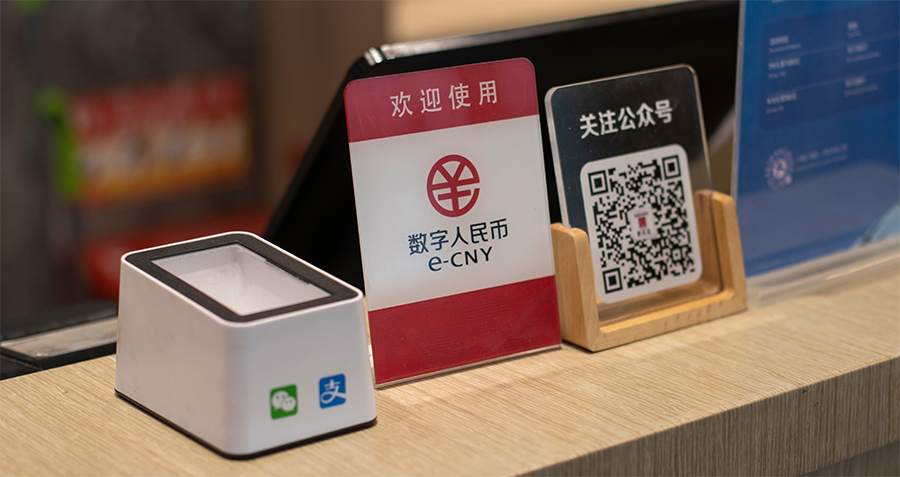“Chaotic” is the word Nico Paulis used to describe his first hour in China, as he tried in vain to pay for a drink at the airport. “I’m Italian and I travel a lot; I’m used to being able to solve any problems,” says the 27-year-old doctor. “But after trying for the first hour, I found it impossible to pay with my credit card. Nothing was working.”
Paulis managed to resolve his problems within the day by registering with China’s two dominant payment methods, Ant Group-owned Alipay and Tencent’s WeChat, and was able to “pay like a local,” fulfilling the campaign line drummed up by the payment apps and local bureaucrats.
The Chinese government has made a push over the last year and a half to make digital payments more visitor-friendly, and Alipay and WeChat—launched in 2004 and 2013, respectively—have heeded that call. The apps have made it significantly easier for travelers to sign up for their services and spend with them, something that was historically anywhere from difficult to impossible.
Although still just over half of the pre-COVID levels, China’s visitor numbers were up by 86.2% year-on-year to 29.2 million in the first 11 months of 2024, and onboarding more of them into China’s vast mobile payment network could provide a tangible boost for economic growth going forward.
Cash out
Even before the pandemic, visitors would often find out the hard way that China has mostly moved on from cash payments.
“China was traditionally a ‘cash is king’ society, which started to change visibly some 25 years ago with the introduction of debit cards, credit cards, the UnionPay payment network, as well as online banking,” says Oliver Sedlinger, CEO of specialized tourism consultancy Sedlinger & Associates. “Since then China has gradually transformed into a mostly cashless society, especially with the rise of smartphones and mobile internet allowing tech giants such as Alibaba and Tencent to build vast digital ecosystems with mobile payments at its core.”
China is now a digital payments powerhouse, clocking up ¥340 trillion ($48 trillion) worth of third-party online payments in 2023. But until recently, the mobile payment network was largely closed to overseas tourists who often found themselves unable to pay for things without the apps.
In China, shoppers scan a merchant’s quick-response (QR) code, or vice versa, to transact—a setup pioneered by Alipay and WeChat at the start of the 2010s. The QR codes are linked to existing financial infrastructure such as bank accounts, bank cards, and clearing and settlement systems.
The ubiquity of QR codes in China—where they were used to settle 95.8% of mobile payments in 2022—has been replicated across swathes of Asia, and paying via QR codes is now commonplace in India, South Korea, Vietnam, Indonesia, Malaysia and Thailand. The continent’s embrace of QR codes sets it apart from Europe and North America, where the adoption and prominence of contactless card payments have reduced the need or desire for QR payments.
Cash accounted for only 3.95% of the total money in circulation in October 2024, and while there have been 9.859 billion bank cards issued as of mid-2024—seven per person on average—they are mostly just used for ATM withdrawals rather than in-person payments.
The Chinese yuan remains a currency with limited convertibility, which limits foreign exchange for visitors before they arrive in-country, and setting up Alipay and WeChat Pay is also not straightforward. Registration requires proof of identity, a local phone number and a local bank account—with the latter two difficult to obtain for short-term visitors. Recent changes allow foreigners to use international phone numbers and email addresses for verification.
“In the past, registration was difficult due to extensive documentation requirements, and things might get complicated when the passport expires and the account has to be closed and reopened under the new passport number,” says Ming Yii Lai, Research Manager at Daxue Consulting. “These platforms even required foreign users to link their accounts to a Chinese bank account. Now, they can link to international credit cards under certain banks.”
“The complication that international visitors have faced in the past is that digital payment systems are generally tailored to local conditions and work best for users living in those markets,” says Bo Sun, CMO of Trip.com Group. “Whereas as many as 90% of outbound Chinese travelers have said they would prefer to use their mobile wallets when traveling abroad, international visitors less accustomed to these new payment methods have historically been left with few options.”
The changes haven’t been completely bulletproof, with Paulis unable to receive verification codes by text message until he used a local cell number after arriving in China. Neither is using all of the app features an easy process, as, though both apps are available in foreign languages—18 for WeChat and 16 for Alipay—swathes of their ecosystems are only in Chinese.
Outside of the payment apps, there have also been recent changes to card payments. For years Western card payment networks Visa and Mastercard were blocked from expanding their businesses in China—despite rules in 2017 that removed formal obstacles to foreign participation. But this has started to change as a Mastercard joint venture started processing domestic payments in China in May 2024.
‘Like a local’
The long-overdue ability to link overseas cards to China’s payment systems coincided with attempts to boost post-pandemic travel to, and international business in, China.
“To re-start international inbound travel to China and give a welcome boost to the local tourism industry, over the course of 2023 and 2024 the government introduced a number of policies that were designed to make travel to China as well as traveling within the country easier and more convenient for foreign guests,” says Sedlinger. “Favorable visa policies and new guidelines for payment methods are two very prominent examples of these policies.”
The stringent identity verification previously necessary for full functionality in WeChat Pay and Alipay has also been dialed down. For instance, in March 2024, Ant announced the annual spending limit for unverified users would be quadrupled from $500 to $2,000, while those who did register their ID would be able to spend $5,000 in a single transaction compared with $1,000 previously. The changes were implemented after China’s central bank freed up Ant and Tencent to enable such increases.
The two companies have also sought to make their apps more user-friendly. In mid-October, WeChat received an update that enabled “mini-apps”—lightweight cloud-based programs built into WeChat—to be translated into other languages. These mini-apps are available from third-party brands such as Muji, KFC and Starbucks to provide more advanced services, and are hugely popular for their convenience.
Simplifying payments for visitors plays a small role in China’s wider efforts to revive inbound tourism and build soft power, part of which is the “Nihao! China” tourism campaign. “As a destination, with its rich culture, cuisine, and landscapes, China has so much to offer for international tourists,” says Sun. “In recent years and complementing the ‘Nihao! China campaign’, the country has made strides in making travel easier and more accessible for international tourists.”
Cutting payment barriers for foreign visitors also makes financial sense for businesses like Ant and Tencent as a new source of transaction volume growth.
Hard spend
While the changes have been well received, visitors still face teething problems when it comes to paying. Account suspensions are common and resolving them can be challenging for non-Chinese speakers, and users may also find themselves quickly racking up foreign transaction charges. Although WeChat and Alipay waive foreign credit card fees for transactions under ¥200, they levy a 3% charge on purchases above this amount.
Even when linked to Alipay and WeChat, foreign cards are not universally accepted in China. Merchants in China have been known to decline payment through the apps if the source of funds is a foreign card, as the merchant fees are significantly higher.
Despite the progress made in the past 18 months, there are also functionality limitations for non-Chinese users. Current restrictions include an inability to add money to app wallets using overseas cards, a ban on peer-to-peer transfers, and not being able to scan personal QR codes to make payments.
The obstacles are somewhat niche and can be explained by concerns about money laundering and scams, but they also suggest authorities are not ready to embrace the full integration of short-stay foreigners.
User experiences remain inconsistent too, with services working for some but not others. Ben, an electrical engineer on a work trip from the UK, linked his Barclays-issued bank card to local ride-hailing app Didi without issue but failed with Alipay and WeChat.
“I’ve been paying contactless and chip-and-pin,” he says. “It’s been a bit challenging because I have to look for shops that accept contactless payment. I have wanted certain things like food and water and, unfortunately, have had to go to a different shop just because I’m limited with the Barclaycard.”
In for a penny, in for a pound
The issues are not deal breakers for most travelers to China and are largely solvable. Improving the setup process for connecting bank cards to Alipay and WeChat would likely require little work, but pay dividends in customer satisfaction. Likewise, enabling visitors to do more with the apps would allow China to evolve its “pay like a local” slogan to “live like a local.”
Embracing separate Visa and Mastercard payments would be welcome too, and reaffirm Beijing’s claims that it is continuing to open up previously walled-off corners of the Chinese economy to foreign money and participation. After all, few schemes offer the same convenience as the major credit card networks in terms of operating across borders.
“There is a systemic element to many of the difficulties, which is founded in the very nature of international travel and cross-border payment settlement, but I expect that these will be overcome by technology quickly—by improvements on the Chinese side but also internationally,” says Sedlinger.
Payment accepted
There are still greater issues for China to return to the heights of its visitor numbers pre-COVID, mass tourism is still at half the level it was in 2019 and foreign investors are still reluctant to rejoin the economy. Things are improving but there is still a long way to go, and while solving payment issues is a positive step, they are a small solution given China’s aspiration of becoming a global tourism powerhouse by 2035.
The recent moves to unlock China’s mobile payment network for more foreigners were welcome but long overdue. They must now be followed by a broader adoption of international digital wallets, payment technologies and multilingual user interfaces.
“The China inbound market has enormous potential,” says Sun. “Supportive policies are providing the basis for this growth, but it is up to providers to facilitate and unlock this potential. Apart from making existing services more inclusive and accessible, investments and innovations should seek to inspire new, richer experiences.”



















